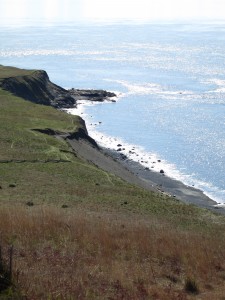If I was a harbor seal I would hope to not be blind cause necropsies are not so kind
So this week we were able to observe a harbor seal necropsy which is essentially a dissection but since we’re biologists we gave it a fun name. Once I got past the smell and the obvious fact that they were cutting open a baby seal it was fascinating. If you have a particular fascination with all things grotesque you can check out Rachel’s blog for a picture. Its pretty cool I’d check it out. While nothing could really compete with getting an inside look at a harbor seal it’s been a pretty good week. We’re preparing for our data collection at the Lime Kiln lighthouse and starting to narrow down our ideas for research projects, which is much harder than I initially though it would be, there’s just so much to ask. We also travelled to Mount Finlayson which was a bit of a hike, but totally worth it as it gave us a great view of cattle pass and the surrounding waters at the southern tip of San Juan Island.
In the meantime we’ve been continuing our work in the classroom and combining our interests and the class theme of sustainability. We were responsible for finding another case study but this time about sustainable fishery practices which was right up my alley, being a fisheries major and all. So I looked at a paper titled Estimating mortality of Atlantic bluefin tuna in an experimental catch-and-release fishery. I think its a requirement that all research papers have an excessively long title. The paper looked at the potential to create a catch-and-release fishery to limit fish mortality. Studies have been done on why people fish and the most often reason is the social bonding experience. Often times its a family tradition passed down from generation to generation, so this way people can still have that experience while conserving the tuna population. The study sought to simulate the proposed regulations of the fishery to get results that would resemble what might happen on the boat. The researchers caught 60 fish and managed to tag 59 of them with PATs which are pop-up archival tags. These tags include microchips with a sensor, transmitter and float. They can measure temperature and depth and are preprogrammed to release from the fish and float to the surface after a certain amount of time or death of the fish. The results show that only 2 fish died, and 4 tags didn’t successfully transmit. The rest of the fish survived except for one. If you noticed earlier I said they caught 60 and tagged 59. So that one was killed during the fight after the fish was hooked. There was an overall mortality rate of  5.1% which is much better than 100% if I do say so myself. I think this is a terrific idea, but much needs to be done before it will be successful. I would love to see them do another study with a greater sampling range of at least over 100 animals to get more accurate results. This type of fishing would also take strong leadership on the boat and experienced anglers. However I love that people are trying to find ways to combine human and environmental interests so that we can enjoy the things we do now for a long time to come.




 Twitter
Twitter LinkedIn
LinkedIn Facebook
Facebook